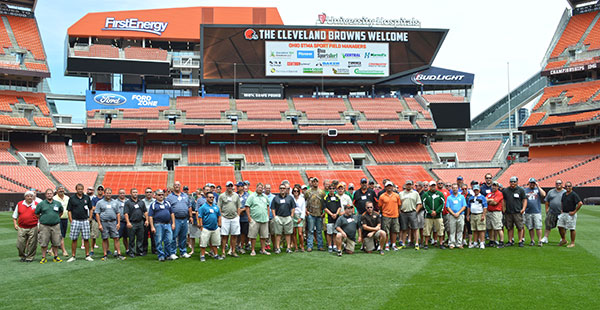Ohio STMA Field Day addresses soils, disease and special events
The Ohio Sports Turf Managers Association held its annual Summer Field Day at the Cleveland Browns’ training facility and at First Energy Stadium on June 24.
Along with tours of the practice facility in Berea, Ohio, and of the stadium downtown, three experts gave presentations on various turgrass-related topics in the film room at the training facility.
Joe Rimelspach, Ph.D., program specialist (extension, turfgrass pathology) at The Ohio State University, shared how to manage gray leaf spot (GLS) and summer patch; Beth Guertal, alumni professor at Auburn University, spoke about soils; and Chris Ecton, sports turf manager for the Pittsburgh Steelers, talked about managing non-athletic events on your field.
Rimelspach’s discussion was focused mostly on GLS. He emphasized that GLS may look like drought conditions, but watering creates a perfect storm for GLS, which thrives in wetness and humidity. He recommends completely changing the turf to a GLS-resistant grass or viewing Rutgers Cooperative Extension’s GLS fact sheet.
Rimelspach handed out a chart compiled by himself and his associates. The table below, provided by Rimelspach, addresses infectious diseases caused by fungal pathogens, and can be used as a reference for sports turf managers.
| This chart was made by Joseph W Rimelspach, Todd E. Hicks and Francesca Peduto Hand from the department of plant pathology at The Ohio State University. Click here to access the original chart in PDF format. | ||||
| SPORT TURFGRASS DISEASE — INFORMATION CHART | ||||
|---|---|---|---|---|
| DISEASE NAME (Pathogen name, the fungus) |
SUSCEPTIBLE GRASS (All capital letters indicate most commonly affected.) |
SIGNS & SYMPTOMS (Signs are the fungus or a part of the fungus, symptoms are the result of the infection on the plant, abnormal appearance or growth.) |
ENVIRONMENTAL FACTORS (Temperature and moisture conditions that favor disease development) |
*MANAGEMENT STRATEGIES (This is the first line of defense and tool to manage disease. After these have been implemented and depending on the circumstances, then fungicide applications are considered.) |
| Brown Patch/ Rhizoctonia Blight (Rhizoctonia solani) |
TALL FESCUE PERENNIAL RYEGRASS BENTGRASS Kentucky bluegrass Fine Fescue (JUVENILE TURF PLANTS) |
– Irregular to circular patches (6”-2’) – Patches variable shades of tan to brown – Outer edges of patch may be darker – Irregular shaped lesions on leaves – Gray to white fungal growth may be present when turf wet and high humidity – May be confused with Pythium blight |
Hot/Wet Days > 80 to mid 90s and warm nights, mid 60s +. Abundant water, wet soils. |
1) Avoid excessive Nitrogen fertilization. 2) Avoid excessive watering and poor drainage. 3) Increase air circulation by removing surrounding vegetation and increase sun light. 4) Manage to prevent lush succulent turfgrass plants. |
| Dollar Spot (Sclerotinia homoeocarpo) |
BLUEGRASS BENTGRASS Fine Fescues Perennial Ryegrass |
– Circular tan patches/spots (1-6”) – Leaf lesions light tan with dark edges – Leaf lesions go across leaf blade (a band) – White fungal growth may be present in early morning when dew present |
Moderate days 60 to low 80s Prolonged periods of wet leaves. Dry Soil – slow leaf growth so poor recovery from damage |
1) Avoid Nitrogen deficiency. 2) Choose resistant grass varieties. 3) Manage watering to minimize time leaves are wet. 4) Water to increase growth. |
| Fairy Ring (Soil borne Basidiomycete fungi) |
All Turfgrasses | – Dark green or brown circles (1-10+’) – Grass in dark green ring may grow taller – Rings may turn brown and die – Mushrooms may grow in the ring – A white fungal mat may be present in the thatch area of the ring and smells musty |
Grow over a wide range of temps. And soil moisture conditions, often favored by moist soils. Brown turf may develop in prolonged hot dry periods. |
1) Improve water penetration; aeration, deep watering and wetting agents. 2) Remove infected soil and sod; replace with clean soil and sod or seed. |
| Gray Leaf Spot (Pyricularia grisea) |
PERENNIAL RYEGRASS Tall fescue (in S.E. USA) St. Augustinegrass (in S. USA) |
– Starts as v. small dark spots/flecks – Leaves often quickly wither and die – Irregular patches to large areas die – Only P. ryegrass affected, other grasses and weeds are not affected – No fungus (mold) is found on plants |
Prolonged hot humid weather patterns in late summer and fall, long summer stress conditions for cool season grasses. Moist soils (turf may appear wilted but soil moist). |
1) Plant resistant varieties or avoid P. ryegrass. 2) Avoid lush turfgrass, use moderate fertilization. 3) Manage watering to minimize time leaves are wet. 4) Use resistant grass species. 5) Minimize turf stress; reduce compaction, avoid chemical injury (herbicides). |
| Leaf Spot/Melting Out (Drechsler & Bipolaris spp.) |
KENTUCKY BLUEGRASS (Common bluegrasses) Fine fescue Perennial Ryegrass |
– Initially very small dark spots on leaves – Spots enlarge in size – Center of spots may be a lighter brown – Leaf sheaths can be entirely – Crowns rot, turf thins (“melting out”) |
Leaf Spot-Cool/Wet Melting Out/Hot Dry (Leaf Spot: spring & fall, Melting Out: summer) |
1) Raise cutting height. 2) Mow frequently to avoid stressing turf. 3) Avoid excessive nitrogen. 4) Avoid frequent watering and wet turf. |
| Powdery Mildew (Erysiphe graminis) |
KENTUCKY BLUEGRASS Fine Fescue |
– White or gray colored powdery appearance to leaf surface (does not easily rub off) – Leaves may yellow and turf stand thin |
Moderate/High humidity Shade Areas of poor air circulation |
1) Reduce shade. 2) Increase air circulation. 3) Use resistant Kentucky bluegrass varieties. |
| Pythium Blight (Pythium species) |
PERENNIAL RYEGRASS BENTGRASS Kentucky bluegrass (JUVENILE TURF PLANTS) (Rather uncommon on mature high cut turfgrasses) |
– May start as small dead spots – Leaves often look dark/black/greasy – Fluffy gray to white ‘cottony’ fungus may be present when disease is active – Spots may run together and have an irregular shape, turf quickly dies, brown – May be confused with brown patch |
V. Hot/Wet (This is a water mold, abundant water is required.) (Days high 80s to 90s ++ and warm nights 70 and above.) Often found in low wet areas, with poor drainage. |
1) Improve soil drainage. 2) Increase air circulation by removing surrounding vegetation. 3) Avoid excess watering. 4) Avoid high rates of Nitrogen. 5) New seedling often affected in hot wet conditions. |
| Red Thread (Laetisaria fusiformis) |
PERENNIAL RYEGRASS FINE FESCUE Kentucky bluegrass Tall Fescue & Bentgrass |
– Patches appear as tan, light pink or reddish – Leaf tips and edges of leaves have fine pink or red strains of fungus present – Size of patches variable (2-12”) |
Moderate/Wet Foliage Prolonged periods of wet leaves |
1) Follow a complete fertilization program, avoid deficiencies in nitrogen and phosphorous. 2) Promote growth by aeration, watering, etc. 3) Use resistant varieties. |
| Rust (Puccini species) |
PERENNIAL RYEGRASS KENTUCKY BLUEGRASS (Some varieties of Key bluegrass are susceptible, some resistant) |
– Starts as small yellow flecks on leaves – Flecks enlarge, to form rust colored raised spots (pustules, spores rubs off on shoes…) – Over all turf yellows and thins |
Moderate/Wet Foliage, Dry Soil (Dry Soil – slow leaf growth so poor recovery from damage.) |
1) Avoid Nitrogen deficiency. 2) Use resistant varieties of Kentucky bluegrass & perennial ryegrass. 3) Water if dry, promote growth. |
| Slime Mold (Myxomycete species) |
All Turfgrasses | – Small pin head size balls/ debris on leaves, vary in color yellow, white, gray, purple, etc. – Cosmetic problem , rubs off leaves |
Moderate to warm temperatures/ Prolonged wet foliage |
1) Mechanically remove by raking or mowing. (Causes no injury, only cosmetic.) |
| Snow Mold / Pink (Microdochium nivale) |
CREEPING BENTGRASS Perennial Ryegrass Kentucky bluegrass |
– Infected grass in patches, bleached, matted – Grass appears slimy when wet – Patches may run together to form large irregular affected areas – Crowns are often alive for recovery. |
Cool wet winters. Saturated, unfrozen, soil for long periods is ideal. No snow required. Occurs in winter and spring. |
1) Avoid lush turf in winter, keep mowing to prevent long turf in winter. 2) Rake leaves. 3) Control drifting snow, prevent piles of snow. |
| Summer Patch (Magnaporthe poae) Necrotic Ring Spot (Ophiosphaerella korrae)These are Patch Diseases |
KENTUCKY BLUEGRASS Fine fescue |
– Begins as dark wilted spots like drought stress (1-3”) and enlarge to patches (about 12’ in diameter) – Shapes are variable, crescents, streaks etc. – Outer edge of circles/patches are brown with green centers are common. – Crowns and roots usually die. |
Warm/Extremes in soil moisture (Fluctuating wet to dry) Poor quality soil, compacted, clay, buried stone and debris, etc. – Usually occurs on sodded lawns with poor site preparation (the turf has a weak or limited root system). |
1) Avoid low mowing & thatch buildup. 2) Maintain soil pH between 6 & 7. 3) Frequent watering when dry to avoid stress. 4) Use very slow-release fertilizer. 5) Renovate the damaged areas with resistant grasses. 6) Difficult to manage with fungicides. |
| *For fungicide recommendations check with county cooperation extension officer and State Land Grant University in your area. | ||||
Guertal focused on the importance of aeration, in whichever form that may be. She shared studies she and her students performed, including core aeration, solid tine aeration and vertical mowing. In one study, the data collected showed that all forms of aeration resulted in higher porosity of the soils than of the soils left untreated.
The presentation by Ecton focused on how to bounce back from possible damage from non-athletic events on fields, such as concerts, NHL events, marathons, kids’ days and — in Heinz Field’s case — a movie scene. Producers “blew up” Heinz Field in 2011 for the Batman movie “The Dark Knight Rises” — only after, of course, promising to pay for a new field installation following the damage.
Following many photos shown of damage to the field caused by non-athletic events, one of about 50 attendees in the audience asked Ecton how he handles the stress.
“I try not to let it get to me,” Ecton says while queuing up a photo of himself with a banged-up, bloodied forehead. “It doesn’t matter so much what you say… The outcome will be what it is, and you have to go with it. Whatever happens, it’s not as bad as this [photo].”
Next year’s date and location Ohio STMA Summer Field day is TBA.











